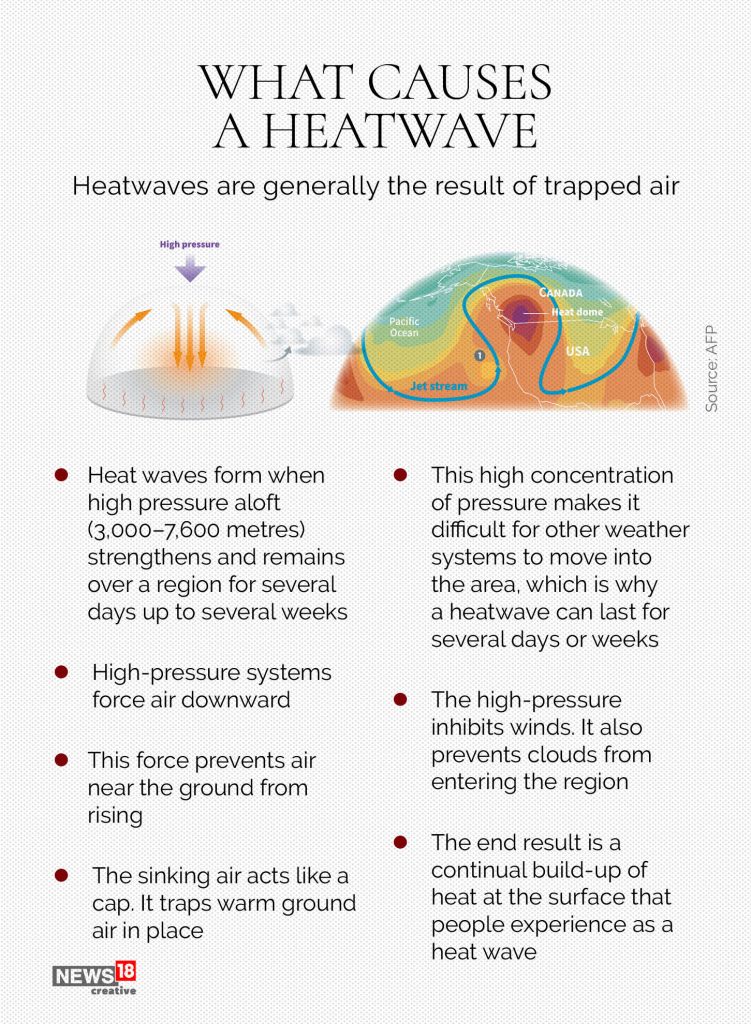Context:
Regions of North America including some parts of Canada recorded temperatures around 47 degrees, causing a “historic” heat wave which is a result of a phenomenon referred to as a “heat dome”.
Relevance:
GS-I: Geography (Important Geophysical Phenomenon, Climatology)
Dimensions of the Article:
- About Heat Waves
- Criteria for occurrence of Heat waves
- What is a heat dome?
- Impact of Heat Dome and Heat Waves
About Heat Waves
- A heat wave is a period of abnormally high temperatures, more than the normal maximum temperature that occurs during the summer season in the North-Western and South-Central parts of India.
- Heat waves typically occur between March and June, and in some rare cases even extend till July.
- Higher daily peak temperatures and longer, more intense heat waves are becoming increasingly frequent globally due to climate change.
- The health impacts of Heat Waves typically involve dehydration, heat cramps, heat exhaustion and/or heat stroke.
- It also causes heat cramps, fatigue, weakness, dizziness, headache, nausea, vomiting, muscle cramps and sweating.
- The extreme temperatures and resultant atmospheric conditions adversely affect people living in these regions as they cause physiological stress, sometimes resulting in death.
Criteria for occurrence of Heat waves
- The heat wave is considered when the maximum temperature of a station reaches at least 40°C for Plains and at least 30°C for Hilly regions.
- If the normal maximum temperature of a station is less than or equal to 40°C, then an increase of 5°C to 6°C from the normal temperature is considered to be heat wave condition. Further, an increase of 7°C or more from the normal temperature is considered as severe heat wave condition.
- If the normal maximum temperature of a station is more than 40°C, then an increase of 4°C to 5°C from the normal temperature is considered to be heat wave condition. Further, an increase of 6°C or more is considered as severe heat wave condition.
- Additionally, if the actual maximum temperature remains 45°C or more irrespective of normal maximum temperature, a heat wave is declared.
What is a heat dome?
- A heat dome occurs when the atmosphere traps hot ocean air like a lid or cap.
- Hot air is trapped by high-pressure fronts, and as it is pushed back to the ground, it heats up even more.
- The condition also prevents clouds from forming, allowing for more radiation from the sun to hit the ground.
- A heat dome is effectively what it sounds like – an area of high pressure that parks over a region like a lid on a pot, trapping heat. They are more likely to form during La Niña years like 2021, when waters are cool in the eastern Pacific and warm in the western Pacific.


How does it form?
- The phenomenon begins when there is a strong change (or gradient) in ocean temperatures. In the process known as convection, the gradient causes more warm air, heated by the ocean surface, to rise over the ocean surface.
- As prevailing winds move the hot air east, the northern shifts of the jet stream trap the air and move it toward land, where it sinks, resulting in heat waves.
- This strong change in ocean temperature from the west to the east is the reason for the heat dome (HD).
Understanding the Heat Dome
- The National Oceanic and Atmospheric Administration (NOAA) says that to understand what causes a heat dome, one should liken the Pacific ocean to a large swimming pool in which the heater is turned on.
- Once the heater is on, the portions of the pool close to the heating jets will warm up faster and therefore, the temperature in that area will be higher.
- In the same way, the western Pacific ocean’s temperatures have increased in the past few decades and are relatively more than the temperature in the eastern Pacific.
Impact of Heat Dome and Heat Waves
- Those living without an air conditioner see the temperatures of their homes rising to unbearably high, leading to sudden fatalities.
- The trapping of heat can also damage crops, dry out vegetation and result in droughts.
- The sweltering heat wave will also lead to rise in energy demand, especially electricity, leading to pushing up rates.
- The heat domes can also act as fuel to wildfires, which destroys a lot of land area in the US every year.
-Source: Indian Express




